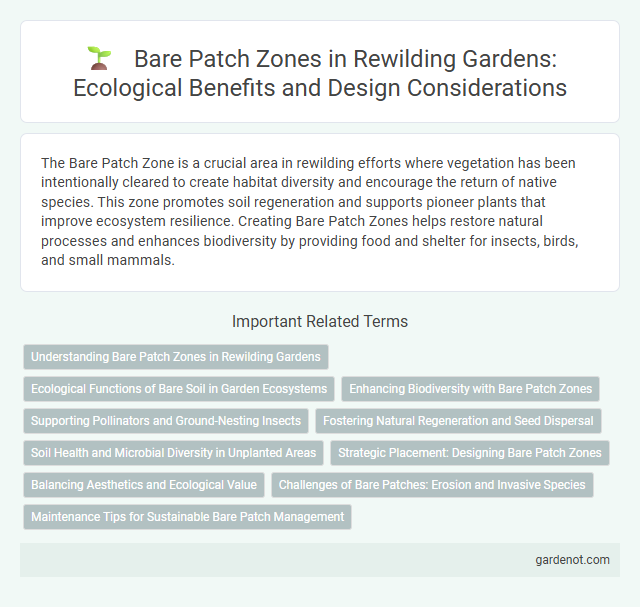The Bare Patch Zone is a crucial area in rewilding efforts where vegetation has been intentionally cleared to create habitat diversity and encourage the return of native species. This zone promotes soil regeneration and supports pioneer plants that improve ecosystem resilience. Creating Bare Patch Zones helps restore natural processes and enhances biodiversity by providing food and shelter for insects, birds, and small mammals.
Understanding Bare Patch Zones in Rewilding Gardens
Bare Patch Zones in rewilding gardens refer to deliberately exposed soil areas that promote biodiversity by providing essential habitats for insects, fungi, and seed germination. These patches support soil microorganism activity, facilitating nutrient cycling and enhancing ecosystem resilience. Understanding their role enables better habitat connectivity and fosters native species regeneration within restoration projects.
Ecological Functions of Bare Soil in Garden Ecosystems
Bare patch zones in garden ecosystems play a crucial role in promoting biodiversity by providing habitat for ground-nesting insects and microorganisms essential for nutrient cycling. These exposed soil areas enhance water infiltration, reducing runoff and facilitating root growth for surrounding plants. Maintaining bare soil patches supports seed germination and establishes a dynamic environment that contributes to ecosystem resilience and soil health.
Enhancing Biodiversity with Bare Patch Zones
Bare Patch Zones increase biodiversity by creating microhabitats that support a variety of flora and fauna, including specialized insects and ground-nesting birds. These patches promote natural regeneration of native plant species by exposing soil and reducing competition from dominant vegetation. Enhanced habitat heterogeneity within these zones fosters ecosystem resilience and species diversity.
Supporting Pollinators and Ground-Nesting Insects
Bare Patch Zones provide essential habitats for pollinators and ground-nesting insects by offering exposed soil necessary for nesting and foraging activities. These zones support native bee species, which contribute significantly to plant pollination and biodiversity within rewilded landscapes. Maintaining bare patches enhances ecosystem resilience by sustaining key insect populations critical for natural regeneration and food webs.
Fostering Natural Regeneration and Seed Dispersal
Bare Patch Zones act as crucial microhabitats that promote natural regeneration by providing exposed soil ideal for seed germination and root establishment. These zones enhance seed dispersal by creating open spaces where wind, animals, and water effectively transport and deposit seeds. Fostering such patches accelerates biodiversity recovery and ecosystem resilience in rewilding projects.
Soil Health and Microbial Diversity in Unplanted Areas
Bare Patch Zones in rewilding projects exhibit unique soil health dynamics characterized by reduced organic matter and altered nutrient cycling compared to vegetated areas. Microbial diversity in these unplanted zones often shifts, with diminished populations of beneficial bacteria and fungi critical for soil structure and plant growth. Understanding these microbial changes aids in developing strategies to restore soil vitality and promote ecosystem resilience in rewilding efforts.
Strategic Placement: Designing Bare Patch Zones
Strategic placement of bare patch zones enhances biodiversity by creating habitats tailored to specific species' needs, promoting ecosystem regeneration and resilience. Positioning these zones in transitional areas like ecotones or along wildlife corridors facilitates species dispersal and interaction, leading to increased genetic diversity. Incorporating spatial analysis and local ecological data ensures bare patches support native flora and fauna while minimizing invasive species encroachment.
Balancing Aesthetics and Ecological Value
The Bare Patch Zone enhances ecological diversity by providing habitat for specialized plants and invertebrates, crucial for maintaining local biodiversity. Balancing aesthetics with ecological value involves designing these zones to appear natural and intentional, using native species that contribute to soil health and wildlife support. Integrating Bare Patch Zones into rewilding projects promotes ecosystem resilience while maintaining visual harmony with surrounding landscapes.
Challenges of Bare Patches: Erosion and Invasive Species
Bare Patch Zones pose significant challenges in rewilding efforts due to increased soil erosion and vulnerability to invasive species colonization. The lack of vegetation exposes soil to wind and water erosion, leading to nutrient loss and habitat degradation. Invasive species exploit these disturbed areas, outcompeting native flora and disrupting ecological balance.
Maintenance Tips for Sustainable Bare Patch Management
Maintaining Bare Patch Zones in rewilding projects requires regular monitoring of soil health and moisture levels to prevent erosion and promote natural regeneration. Applying organic mulches and incorporating native plant seeds can enhance biodiversity and support soil microbial activity. Avoiding heavy machinery and minimizing foot traffic in these areas helps preserve the delicate bare patches essential for specialized flora and fauna to thrive.
Bare Patch Zone Infographic

 gardenot.com
gardenot.com